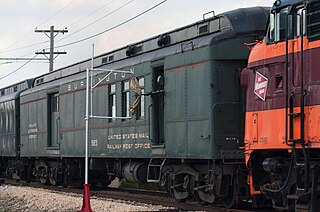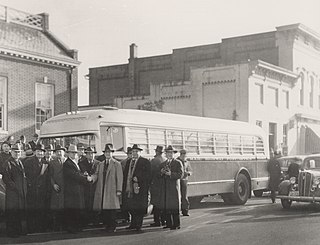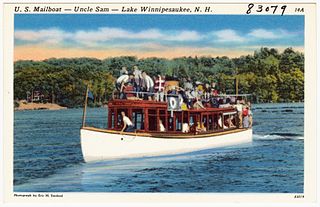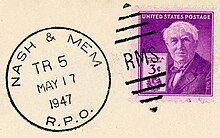
In Canada and the United States, a railway post office, commonly abbreviated as RPO, was a railroad car that was normally operated in passenger service and used specifically for staff to sort mail en route, in order to speed delivery. The RPO was staffed by highly trained Railway Mail Service postal clerks, and was off-limits to the passengers on the train.
The Railway Mail Service (RMS) Library is a major collection of materials pertaining to en route distribution history. Incorporated in May 2003, it can assist researchers interested in Railway Mail Service, route agent, Seapost, Railway Post Office (RPO), and Highway Post Office (HPO) history. The collection has many unique, original-source documents that provide answers to questions dealing with the transportation and distribution of USA Mail between 1862 and 1977, as well as other countries during the 19th century and 20th century.

The term highway post office refers to brightly colored red, white and blue buses used to carry mail to multiple areas over wide distances.
An air mail facility is an installation for airmails of the United States.
Terminal railway post offices were sorting facilities which were established by the Railway Mail Service to speed the distribution of parcel post. These offices were usually located in or near railroad stations in major cities or junction points. Terminal railway post offices operated generally from 1913-1914 into the mid-1960s, before their function was absorbed by post office sectional centers.

From the 1880s until well into the 1950s, virtually all long-distance transportation of United States Mail was performed by the railroads. Specially equipped railway post office (RPO) cars were a part of most passenger trains, the cars staffed by highly trained railway postal clerks who sorted mail as the train sped along its route. The growth of this mail distribution network paralleled the expansion of the railroads, allowing mail to be exchanged between routes at junction points where two railroads crossed or shared passenger terminals.
A Seapost was a mail compartment aboard an ocean-going vessel wherein international exchange mail was distributed. The first American service of this type was the U.S.-German Seapost, which began operating in 1891 on the S.S. Havel North German Lloyd Line. The service rapidly expanded with routes to Great Britain, Central America, South America, and Asia. The Seapost service still employed fifty-five clerks in early 1941. The last route of this type was terminated October 19, 1941, due to unsafe wartime conditions on the Atlantic Ocean. The few remaining Seapost clerks transferred to branches of the Railway Mail Service (RMS). Seapost operations for the US Post Office Department were supervised from a New York City, New York, office.

Post was transported over water in the United States in the later nineteenth and the twentieth century.
The Postal Transportation Service (PTS) was the renamed successor to the Railway Mail Service of the United States Post Office Department from October 1, 1949. Although this branch of the service had been in charge of all transit mail, some parts had little to do with railroads, even though they were still the most important part of the service. In 1950, of the 32,000 clerks assigned to the PTS, only about 16,000 actually worked on trains. The remainder were in terminals, transfer offices, Air Mail Facility, Highway Post Offices (HPO), administrative offices, etc. Boat Railway Post Office, Streetcar Railway Post Offices, and the Seapost Service had already been discontinued. The name of the Chief Clerk's office was changed to District Superintendent's office.
Streetcar railway post office (RPO) routes operated in several major US cities between the 1890s and 1920s. The final route was in Baltimore, Maryland. The Mobile Post Office Society, Affiliate 64 of the American Philatelic Society, has published monographs detailing the operational history of each route.
The Bureau of Transportation of the United States Post Office Department was established in 1960. It was the successor to the Postal Transportation Service (PTS); the PTS had responsibility for mail transportation contracting as well as employees assigned to Mobile Unit and stationary PTS facilities such as Air Mail Facility, Terminal Railway Post Office, or Transfer Office operations. Only the contract issuance and administration responsibilities for mail routes were given to the Bureau of Transportation. Human Resources were transferred to postmasters in the cities where Mobile and Stationary Units were located. This division of activity continued to the end of the Post Office Department and after it became the U.S. Postal Service.
The National Postal Transport Association (NPTA) was a labor union representing workers in the Postal Transportation Service in the United States.

The Hannibal and St. Joseph Railroad was the first railroad to cross Missouri starting in Hannibal in the northeast and going to St. Joseph, Missouri, in the northwest. It is said to have carried the first letter to the Pony Express on April 3, 1860, from a train pulled behind the locomotive Missouri.

Mobile post offices deliver mail and other postal services through specially equipped vehicles, such as trucks and trains.

The Washington–Chicago Express, an American named passenger train of the Baltimore and Ohio Railroad (B&O), was one of four daily B&O trains operating between Washington, D.C., and Chicago, Illinois, via Pittsburgh, Pennsylvania during the 1930s–1960s. Other B&O trains of that period on the route were the Capitol Limited, Columbian, and the Shenandoah.

George Bangs was an American businessman who began his adult life working in private ventures including printing, shoes, farming and journalism before becoming postmaster of Aurora, Illinois, in 1861. During his postal career, he worked with the Railway Mail Service (RMS). There he improved the mail sorting system on trains and was the most prominent advocate of "fast-mail" express mail trains. In 1871, as the RMS General Superintendent, he oversaw the start of the "fast-mail" service which began in 1875. The next year he resigned after Congress cut funding. He died in 1877 and was remembered with an elaborate grave marker denoting his contribution to the postal service.

The Chicago Night Express was an American named train of the Baltimore and Ohio Railroad (B&O) on its route between Wheeling, West Virginia and Chicago, Illinois with major station stops in Newark, Ohio, Mansfield, Ohio and Willard, Ohio. The B&O inaugurated the Chicago Night Express in 1912. It was discontinued in 1956 due to declining passenger demand.
The Fast Mail was a Southern Railway mail and express train that operated between Washington, D.C., and New Orleans, Louisiana. The southbound Fast Mail carried the train number of 97, and was later known by the nickname of "Old 97". One such trip made by the train, on September 27, 1903, derailed at Stillhouse Trestle in Danville, Virginia, and was later known as the "Wreck of the Old 97", for which the service was most well known.

A catcher pouch is a mail bag that can be used in conjunction with a mail hook to "catch" mail awaiting pickup from a moving train. Catcher pouches were most often used by railway post offices in the nineteenth century and the early twentieth century. Its use was limited to exchanges onto moving trains. The specially constructed catcher pouch was grabbed by the catcher mechanism in the passing railway car and the catcher pouch would release from the holding rings on the mail crane. This technique was known as "mail on the fly". Starting in the 1870s the use of this technique of the Railway Mail Service was an important issue in the United States. It was a popular technique and the backbone of the United States Postal Service through the 1930s.










